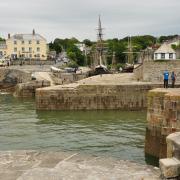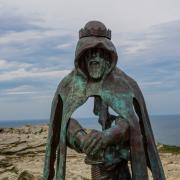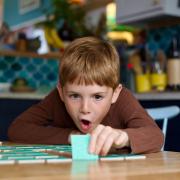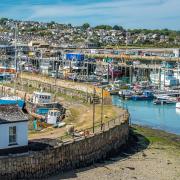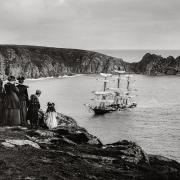It’s a five-million-piece puzzle that has captured the imagination of people across the world. CHRISSY HARRIS talks to the woman behind Lego Lost at Sea.
They stood out against the seaweed and sand on the shoreline - tiny yellow lifejackets, red divers’ flippers, the occasional octopus and even a dragon.
Tracey Williams first started spotting the tiny bits of Lego in 1997, during regular beachcombing sessions in South Devon with her children, then aged six and five.
She later discovered they were the contents of a cargo ship, the Tokio Express, that had spilled its load of 62 shipping containers after getting into difficulty in rough seas, 20 miles off Land’s End.

One of those containers held nearly five million pieces of Lego, the brightly coloured interlocking plastic bricks and pieces loved by generations of youngsters.
As more and more of the – mostly sea-themed - Lego started turning up on Devon and Cornwall’s beaches, Tracey set up a Facebook page for people to document their finds.
Lego Lost at Sea soon became a global news story, quickly building a huge following on other social media accounts.

The washed-up toy parts became a colourful, captivating way to highlight the alarming amount of plastic waste in our seas and on our coastlines.
Tracey, who moved to Cornwall in 2010, has now written a book, called Adrift, which documents the curious tale of the Lego Lost at Sea phenomenon and what it tells us about our oceans.

“There are so many facets to it,” says Tracey, at home in North Cornwall after a morning’s beachcombing session. “It’s shocking and fascinating at the same time.
“People describe my social media pages as being part whimsical and part doom-laden. It’s that mixture of the two.”
Many of the pages on the Lego Lost at Sea social media channels and the pages in the book are filled with strangely beautiful arrangements of plastic finds.

Each one has a theme, from discarded toothbrushes to fake flowers and plastic hair slides. All are initially mesmerising and often inspire a sense of nostalgia, especially the ones that display old plastic toys, some of which are thought to date back to the 1950s.

“The more I looked for Lego, the more I noticed everything else that was there,” says Tracey. “It’s been the same for many people. They start out looking for Lego and realise just how much plastic there is.
“I can’t tell you how many dumpy sacks I’ve got in my back yard, filled with plastic that I’ve just picked up in recent weeks. And it’s not the glamorous stuff - just plastic strips and bottles, all things that have been lying on the seabed and been swept ashore with the kelp recently.”
Tracey is up and out early most mornings on her nearest beach (she won’t reveal her go-to spots, just that she travels to ‘lots of beaches’) and regularly takes part in local clean-ups.
“One of the biggest problems at the moment is the single-use sand toys, the buckets and spades etc that are so cheap, they just break the first time they’re used,” she says. “Last year, I picked up over 400 across two beaches over the space of a summer.”
Tracey’s more colourful collections are often handed over to local artists, some of whom use them to highlight the scale of plastic pollution.
But Tracey is keen to point out that despite the striking visual appeal of her neatly arranged plastic finds, this was never meant to be an art project.
“I just thought it was interesting to see it all, like a visual record or an online journal,” she says. “It’s quite interesting looking back because you can see how things change over the years.”
Clothing, textiles and covid-related debris, such as facemasks, are some of the more common recent shoreline discoveries. Not quite so appealing as green Lego dragons (now much sought after) but they make the same point.
“The whole Lego story is quite a good way of talking about ocean plastic in a way that we can identify with,” says Tracey. “It’s opened people’s eyes.”

And the Lego story is far from over. It’s thought that most of the original spill ended up on the seabed and there are still many pieces unaccounted for, including magic wands, black bats, cowboy hats and witches’ hats.
After the cargo spill, Lego’s shipping department put together an incredibly detailed inventory that not only revealed which bricks had been on board the Tokio Express but also how many of each piece had plummeted into the deep.
To give a sense of the scale of the cargo, there were 39,000 black propellers, 4,200 black octopuses, 514 green dragons and 51,800 sharks. No sharks have ever been reported as found.

“There’s still lots we need to find out,” says Tracey, who is hoping that the story will one day be turned into a documentary. “Some of the Lego is still gradually making its way ashore, swept along the seabed on ocean currents,’ she adds. “It could carry on washing up here for decades or even hundreds of years.
“What we’ve learned from the Lego story is that plastic doesn’t go away.”
Adrift: The Curious Tale Of The Lego Lost At Sea, by Tracey Williams, is out now (Unicorn Publishing).
See Lego Lost at Sea on Facebook, Instagram and Twitter

Long lasting toys
Tracey Williams met Tim Brooks, Lego’s vice president for environmental responsibility over a video call in August 2021 to talk about the lingering impact of the Lego spill.
He said: “We don’t want any Lego bricks to be in the sea – ever.
“‘We’re absolutely passionate about keeping Lego bricks out of nature.”
“One of the things we’re most proud of is that Lego is compatible and long lasting,’ Tim says. ‘There’s no logical reason why you would ever throw a Lego brick out. They’re safe, durable and can be handed down from generation to generation. Plastic is a great material but it’s great in context. It definitely belongs in the home or in schools, not in the ocean.’
These days it’s rare for Lego bricks to be sent by sea.
‘Nowadays we tend to manufacture Lego in our local markets. A third of our bricks are made here in Billund in Denmark and transported by road to Europe.”

Sea life
As part of her research, Tracey Williams teamed up with scientists at the University of Plymouth to test how long Lego could last in the sea. Between 100 and 1,300 years, they concluded.

The other blocks
For the past few years, 100-year-old rubber-like blocks from Indonesia have been mysteriously washing up on beaches in the UK and northern Europe. The Titanic has been suggested as one of the possible sources. Tracey Williams carried out extensive research to try to solve the puzzle of the Tjipetir blocks.
She managed find out about the Japanese liner the Miyazaki Maru, which had sunk during World War One and had been carrying the Tjipetir blocks.
Although it’s not confirmed, the Miyazaki Maru is the favoured possibility as the source of the washed-up blocks, according to the UK government's Receiver of Wreck.





